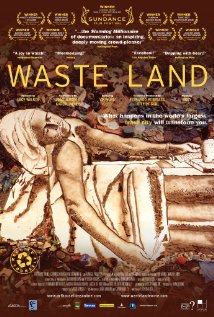Mulvane Art Museum features art film Series
July 10, 2014
The film “Waste Land” was played July 8 and will play again at 6 p.m. July 22 in the Mulvane Art Museum. Nominated for many awards, including an Oscar, the feature film Wasteland (2010) won prizes at many film festivals. One prize it received was at Sundance.
Successful artist Vik Muniz decides to transform the lives of the people who scour the world’s largest landfill, which exists in Rio de Janiero, for recyclables. These are the poor people of Rio who dwell in the “favelas” or slums. The recyclers are called catadores.
The documentary tells a poignant story about the lives of the people who exist and work in the stinking landfill of Rio where, the movie states, the roughest people you can think of end up—this is the end of the line. Muniz’s plan is to transform the catadores into true pieces of art. In the movie Muniz’s wife asks about what kind of damage, change or emotional toll could happen when trying to change the lives of others. Why change catadores, recyclers who try to help people rethink what trash is and what it is not?
Taking a look at the lives of some of the characters, like Irma, who cooks stews from edible meat from the landfill for the workers, viewers can see how life emerges and businesses emerge even in a place as squalid as a landfill. We meet an 18-year-old woman and 17-year-old boy who have been working in the garbage dump since they were very young. Many children have lost their parents. Zumbi, a lover of books, foraged a library from discarded books that he then hung up to dry and placed in his library for the betterment of the catadores.
“Waste Land” is a biography of a people and a look at their lot in life in the context of a community. It shows courage and resilience despite poverty and depressing living conditions. Many are proud of the fact that they are making an “honest” wage rather than selling drugs or becoming prostitutes.
Through the documentary viewers are able to see the power of art and the fortitude of the human spirit. Muniz chooses six of the catadores to incorporate into artwork surrounded by the waste from the landfill. The outcome is evocative of high art, but comes from one of the lowliest of places.
“Exit Through the Gift Shop” by Banksy (2010) is the second feature documentary playing at the Mulvane museum at 2 p.m. July 15 and again at 6 p.m. This film was also nominated for an Oscar and won an Independent Film Award.
It is a story about an oddball French shopkeeper Thierry Guetta in Los Angeles who becomes a quasi-filmmaker, composing movies of all he sees and storing them in growing boxes in his home. He is obsessed and one day decides to film graffiti artists. Later he attempts to find graffiti legend Banksy—and does.
Banksy, a graffiti artist infamously known worldwide cultivates an anonymity that cloaks him from the curious and the law. Among his many “tags,” Banksy has left his graffiti, throughout his native England, on a barrier wall on the left bank in Palestine, on a wall in a forsaken area of New Orleans after Katrina and on a ride at Disneyland in California.
Banksy, who will not let Guetta show his face on camera decides one day to turn the camera on Guetta, who begins his own graffiti (or street art) as “MBW”—Mr. Brainwash and attempts to become a legend in his own time. But the movie takes a few twists and gurgles and in more than one instance proves that beauty and the money it makes is indeed in the eye of the beholder, especially in a land as fickle as Los Angeles.
“Exit Through the Gift Shop” is a look at eccentric people who would like to change the world with their artwork and did change, if not the world, for a moment in time.



